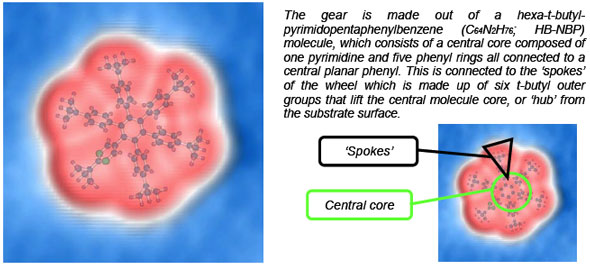| Sep 05, 2011 |
A Guinness World Record for Singapore with A*STAR IMRE's world's smallest working gears
|
|
(Nanowerk News) The Institute of Materials Research and Engineering (IMRE), a research institute of Singapore's Agency for Science, Technology and Research (A*STAR), puts Singapore into the Guinness Book of World Records with its controllable, molecule-sized gears, which are officially the world's smallest! The gears are up 100,000 times smaller than the width of a single strand of hair and can only be viewed using powerful microscopes.
|
|
It's official! Researchers from IMRE have put Singapore into the Guinness Book of World Records by successfully demonstrating the world's smallest fully controlled rotation of a molecule-sized gear.The research opens the way for the futuredevelopment of molecule-sized machines that may lead to innovations like pocket-sized supercomputers, miniature energy harvesting devices and data computing on atomic scale electronic circuits.
|
|
Before the team's success, reported experiments attempting to rotate single molecules resulted in their random and uncontrolled rotation. The scientists from IMRE were able to solve the matter by manipulating the molecule with the tip of a Scanning Tunnelling Microscope, which is a powerful microscopy tool capable of imaging materials down to their atoms but which can also be used to manipulate single molecules and atoms on conductive surfaces.These experiments were done at cryogenic temperatures, of approximately -266°C, in an ultrahigh vacuum environment.
|
 |
|
Looking like a wheel, the gear is made out of a hexa-t-butyl-pyrimidopentaphenylbenzene (C64N2H76; HB-NBP) molecule, which consists of a central core composed of one pyrimidine and five phenyl rings all connected to a central planar phenyl. This is connected to the 'spokes' of the wheel which are made up of six t-butyl outer groups that lift the central molecule core from the substrate surface. The molecule was mounted on an atom-sized impurity that acted as a pinning axle and manipulated using the microscope's tip which turned the molecule step-by-step.
|
|
"This is an example of pioneering science that is technologically significant. With such innovations at the molecular level, today's molecules may be tomorrow's machines," explained Prof Andy Hor, IMRE's Executive Director.
|
|
The breakthrough gear was developed in 2009 and was published in one of science's most prestigious materials research journals, Nature Materials.
|

